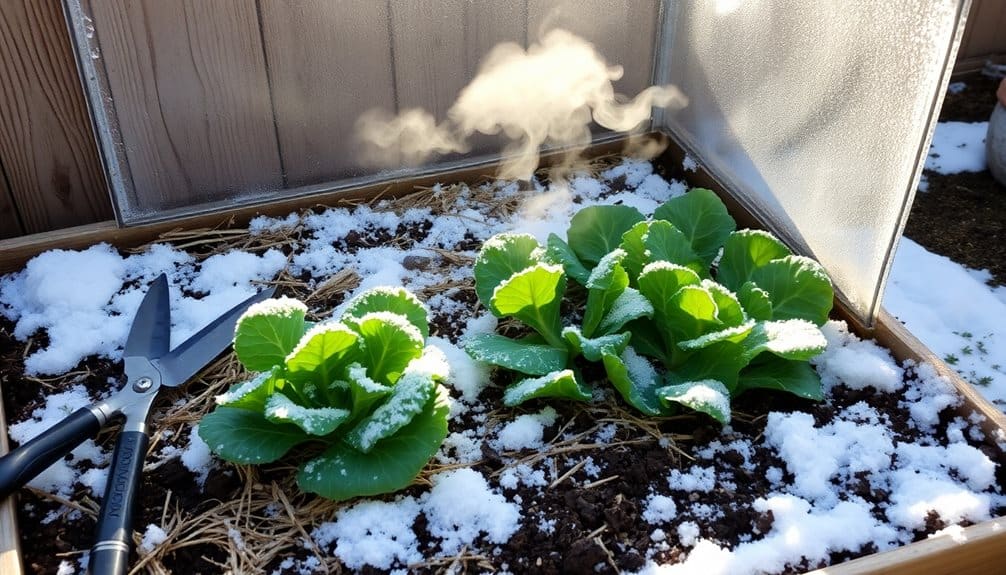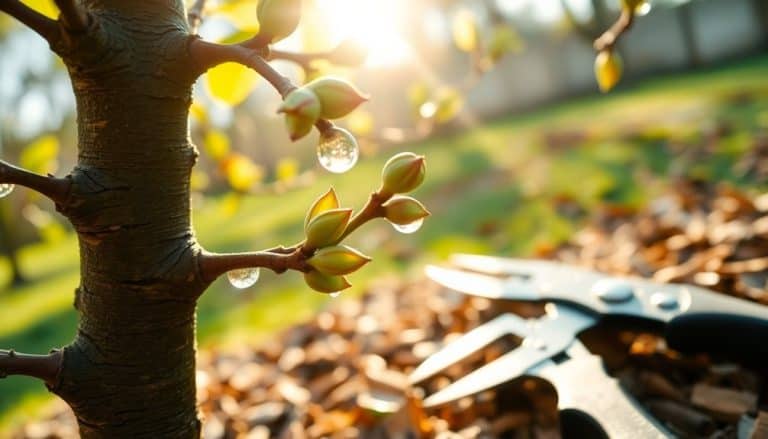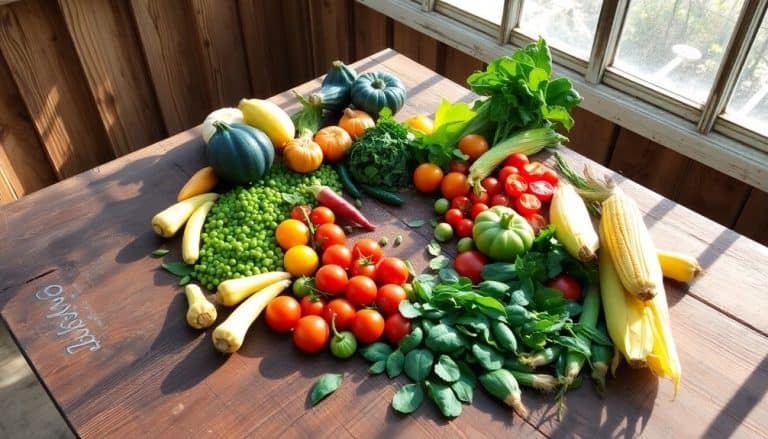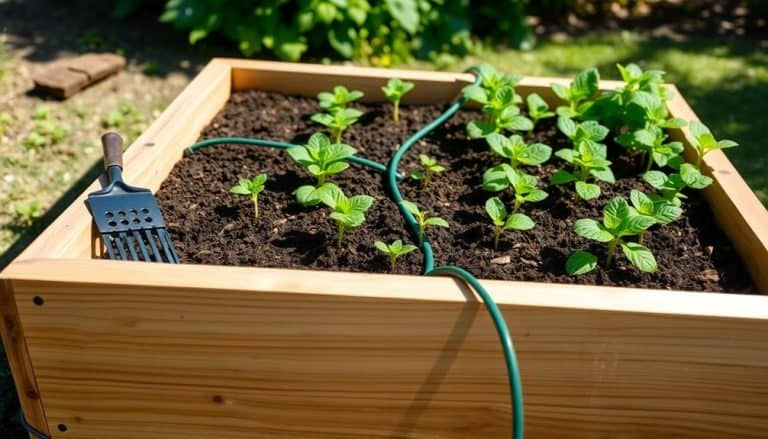This website contains affiliate links. Some products are gifted by the brand to test. As an Amazon Associate, I earn from qualifying purchases. The content on this website was created with the help of AI.
You’ll need to determine your USDA hardiness zone first to select appropriate cold-hardy plants for winter gardening. Focus on root vegetables like carrots and turnips, plus leafy greens such as kale and spinach that actually become sweeter after frost exposure. Protect your plants using cold frames, row covers, or greenhouses, depending on your climate severity. Essential tools include insulated gloves, soil thermometers, and protective structures. Maintain proper soil moisture and monitor temperatures regularly, while creating microenvironments that retain heat. As you develop your winter garden strategy, you’ll discover numerous techniques to extend your growing season year-round.
Key Takeaways
- Choose cold-hardy vegetables like kale, carrots, and Brussels sprouts that can withstand frost and develop sweeter flavors in cold weather.
- Protect plants using row covers, cold frames, or greenhouses, especially in zones 3-6 where winter temperatures drop significantly.
- Apply 3-4 inches of mulch around plant bases and ensure proper soil moisture to help plants survive freezing temperatures.
- Monitor weather patterns and inspect garden structures bi-weekly, clearing snow accumulation to prevent structural damage.
- Start with a soil thermometer, insulated gloves, and protective coverings as essential tools for successful winter gardening.
Understanding Winter Growing Zones
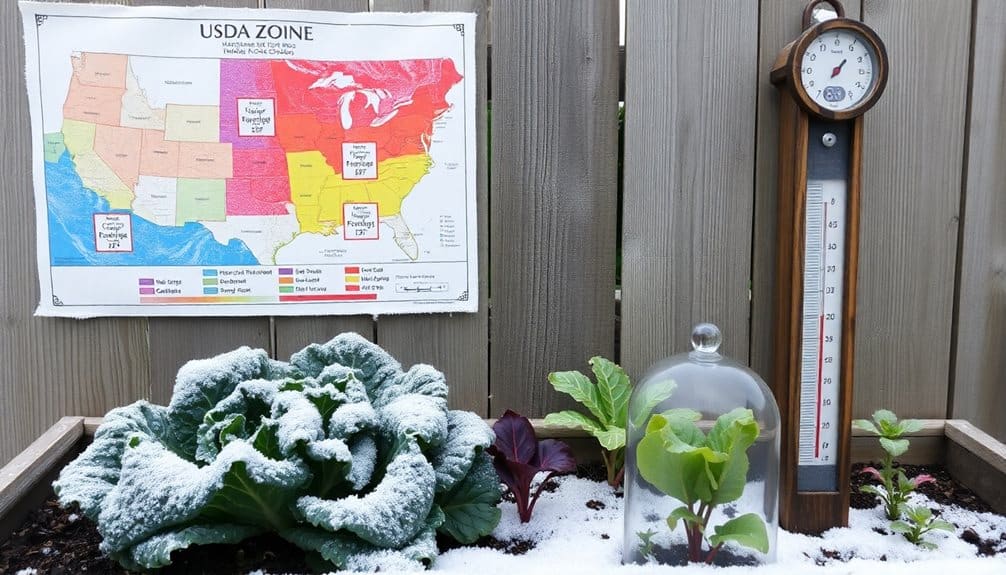
Winter growing zones are the foundation of successful cold-season gardening, determining which plants can survive in your specific climate during the harshest months. You’ll need to identify your USDA hardiness zone, which ranges from zones 1-13, with zone 1 being the coldest (-60°F to -50°F) and zone 13 being the warmest (60°F to 70°F).
Your growing zone directly impacts plant selection and timing. You’ll find this information critical when choosing cold-hardy vegetables, planning protection methods, and establishing planting schedules. If you’re in zones 7-10, you can grow various winter crops with minimal protection, while zones 3-6 require more robust solutions like cold frames or greenhouses.
Consider your microclimate within your zone, as factors like elevation, building proximity, and wind patterns can create warmer or colder spots in your garden. You’ll want to map these variations to maximize growing success. Urban areas often register 5-10 degrees warmer than surrounding rural regions, creating opportunities for zone-pushing. Understanding these nuances helps you select appropriate plant varieties and implement effective winter protection strategies for your specific location. For optimal temperature control in harsh winter conditions, consider installing a greenhouse with double-wall polycarbonate panels that provide superior insulation and heat retention.
Cold-Hardy Plants Worth Growing
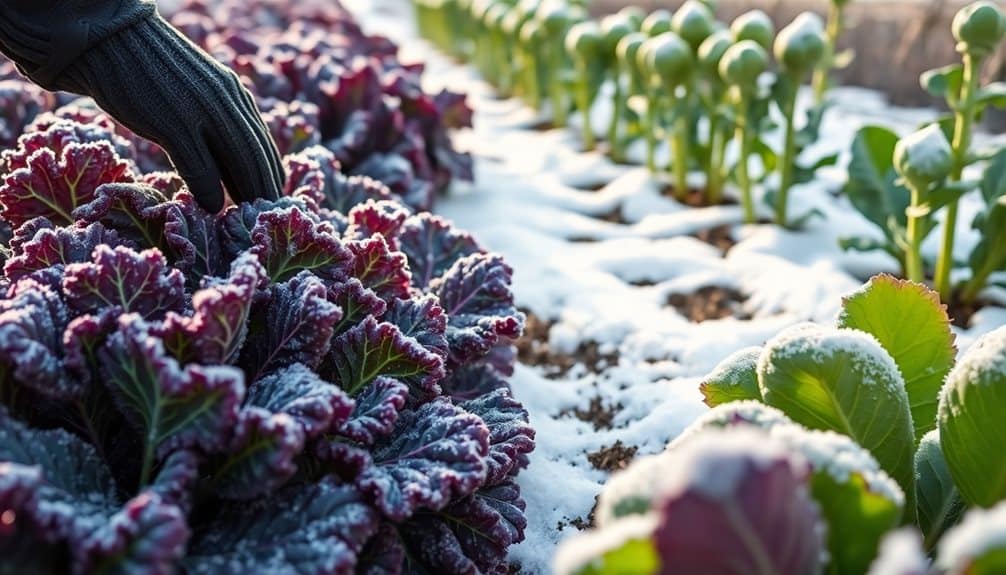
Selecting cold-hardy plants can transform your winter garden from dormant to vibrant, with numerous vegetable varieties thriving in temperatures as low as 20°F (-6°C). You’ll find remarkable success with root vegetables like carrots, parsnips, and turnips, which actually develop sweeter flavors when exposed to frost. Kale, Brussels sprouts, and collard greens strengthen their cellular structure in response to cold, becoming more resilient and flavorful.
For reliable winter harvests, you’ll want to include spinach and Swiss chard, which maintain steady growth even during shorter daylight hours. Garlic and onions, planted in fall, develop strong root systems throughout winter, while cold-tolerant herbs like thyme, sage, and winter savory continue producing aromatic leaves. Consider incorporating winter cabbage varieties and leeks, which stand firmly against freezing temperatures.
Don’t overlook Asian greens such as mizuna and tatsoi; they’re exceptionally cold-hardy and quick to mature. For ideal results, you’ll need to establish these plants before severe weather sets in, allowing their root systems to develop fully. Most cold-hardy varieties benefit from row covers or cold frames, extending your growing season considerably. A raised garden bed with a minimum soil depth of 12-14 inches provides optimal growing conditions for winter root vegetables.
Essential Winter Gardening Tools
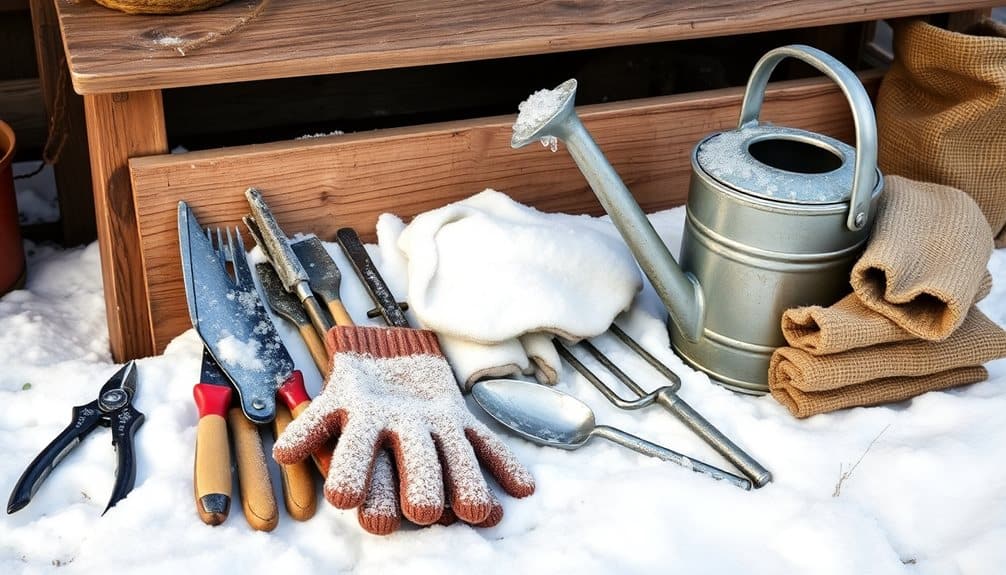
To successfully cultivate cold-hardy plants, you’ll need a specialized set of tools designed for winter gardening conditions. Start with insulated gloves that provide both warmth and dexterity, and invest in a quality snow shovel to clear paths to your growing areas. You’ll also need row covers, cold frames, or portable greenhouse structures to protect plants from freezing temperatures.
Essential hand tools include a soil thermometer to monitor ground conditions, pruning shears for maintenance, and a sturdy garden fork for harvesting root vegetables from partially frozen soil. Don’t forget heavy-duty plant stakes and twine to support plants under snow weight. A wheelbarrow with winter-ready tires will help transport supplies across frost-hardened ground.
For season extension, you’ll require clear plastic sheeting, frost blankets, and sturdy hoops to create protective tunnels. Keep a collection of plant markers that won’t deteriorate in harsh conditions, and maintain backup heating systems for greenhouse environments. Store these tools in a weather-resistant shed or container, and make certain they’re clean and dry after each use to prevent rust and degradation in winter’s moisture-heavy conditions. Consider installing a WiFi thermometer system in your greenhouse to monitor temperatures remotely and receive instant alerts when conditions fall outside optimal ranges.
Protecting Plants From Frost

Frost’s damaging effects on plants can be mitigated through strategic protection methods that extend beyond basic covering techniques. You’ll need to create microenvironments that maintain temperatures above freezing while ensuring proper airflow and moisture control. Installing cold frames, cloches, or row covers provides an effective barrier against frost damage while allowing sunlight penetration.
When temperatures drop, you’ll want to focus on heat retention by utilizing thermal mass principles. Place water-filled containers or dark-colored stones near vulnerable plants – they’ll absorb heat during the day and release it gradually at night. You can also create an insulating layer by applying a 3-4 inch mulch barrier of straw, leaves, or bark around plant bases.
For container plants, you’ll achieve better protection by clustering them together and moving them against south-facing walls. If you’re expecting severe frost, implement a two-layer protection system: first, wrap individual plants with breathable fabric, then create a larger protective dome using frost blankets or agricultural fleece. Don’t forget to monitor soil moisture levels, as well-hydrated plants withstand frost better than dry ones. Consider using a portable mini cloche which can achieve up to 95% germination rates while providing excellent frost protection for smaller plants.
Indoor Winter Growing Tips
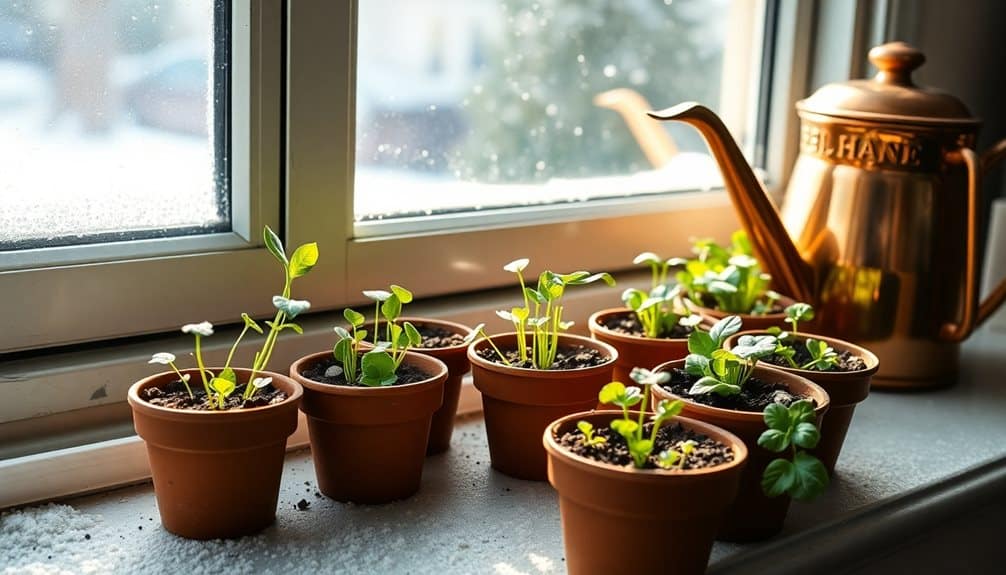
While outdoor gardens face winter’s challenges, your indoor growing space offers a controlled environment for year-round cultivation. You’ll need to maintain temperatures between 65-75°F, regulate humidity levels at 40-60%, and provide adequate air circulation to prevent mold growth and strengthen plant stems.
Position your plants near south-facing windows to maximize natural light exposure, supplementing with LED grow lights for 12-16 hours daily when daylight hours diminish. You’ll achieve ideal results by placing lights 6-12 inches above plant tops, adjusting height as they grow. Monitor soil moisture carefully, as indoor heating systems can accelerate evaporation.
Select plants suited for indoor winter growing: herbs like basil, mint, and parsley; leafy greens such as microgreens, lettuce, and spinach; and compact vegetables like cherry tomatoes and dwarf peppers. You’ll want to use well-draining potting mix and containers with drainage holes. Implement a regular fertilization schedule using water-soluble nutrients at half-strength to prevent nutrient deficiencies caused by limited root space. Don’t forget to inspect plants weekly for pests, addressing any issues with organic solutions before infestations spread. Consider using full spectrum lighting between 380-780 nanometers to replicate natural sunlight and support all growth stages from seedling to flowering.
Winter Garden Maintenance Schedule

A successful winter garden maintenance schedule revolves around three core activities: protective measures, structural upkeep, and preparation for spring. You’ll need to perform protective measures weekly, including checking frost protection materials, adjusting coverings after snow or ice storms, and monitoring temperature fluctuations that could affect your plants.
For structural maintenance, inspect your garden frames, hoop houses, and cold frames bi-weekly. You’ll want to clear snow accumulation from structures, tighten any loose components, and repair damage promptly to prevent collapse. Check irrigation systems monthly and drain exposed pipes to prevent freezing.
Your spring preparation tasks should begin in late winter. Start by testing soil pH levels and amending as needed. You’ll also want to clean and sharpen tools, order seeds, and create detailed planting schedules. Remove any diseased plant material and add it to a separate compost pile from your healthy yard waste.
Document weather patterns and plant performance throughout winter to optimize next year’s planning. You’ll find this data invaluable when adjusting your cultivation strategy and selecting cold-hardy varieties for future seasons.
Frequently Asked Questions
Can I Start Composting During Winter Months?
Like Mother Nature’s year-round recycling program, composting doesn’t hibernate. You can absolutely start composting in winter. While decomposition slows during cold months, you’ll still build valuable organic matter. Keep your pile insulated with straw or leaves, continue adding kitchen scraps, and maintain a 3:1 ratio of brown to green materials. You’ll notice the center stays warm even in freezing temperatures, as beneficial microbes work their magic.
How Do Snow and Ice Affect Soil Ph Levels?
Snow and ice can considerably alter your soil’s pH through a process called “snow chemistry.” When snow accumulates, it traps atmospheric pollutants that create acidic conditions once melted. You’ll find that repeated freeze-thaw cycles accelerate mineral breakdown in your soil, potentially lowering pH levels. However, if you’ve got alkaline soil, winter precipitation can actually help neutralize it by leaching out excess basic compounds.
What Time of Day Should I Water Plants in Winter?
Like a gentle morning symphony, early daylight hours are your golden window for winter watering. You’ll want to water between 10 AM and 2 PM, when temperatures peak and your plants can absorb moisture before nightfall. This timing prevents water from freezing around root systems and allows excess moisture to evaporate from foliage, reducing the risk of fungal diseases and frost damage.
Do Winter Gardens Attract Different Pests Than Summer Gardens?
You’ll notice different pest patterns in winter gardens compared to summer ones. While many insects become dormant, you’ll still face challenges from slugs and snails that thrive in cool, damp conditions. Winter moths and aphids remain active in moderate temperatures, and rodents like voles and mice seek food and shelter in your garden. Root maggots can damage your winter brassicas, while birds may target exposed crops.
Should I Fertilize My Winter Garden if Plants Grow Slower?
You’d think slower growth means less feeding, but ironically, your winter plants need fertilizer more than ever. While growth appears sluggish above ground, roots are actively developing beneath the soil. Apply a phosphorus-rich fertilizer at half the summer rate to support root development and nutrient uptake. Continue feeding every 4-6 weeks, but avoid high-nitrogen blends that could trigger unwanted foliage growth during cold spells.

